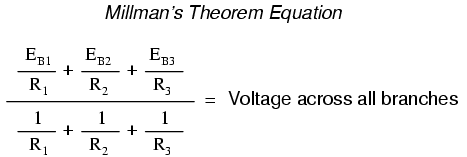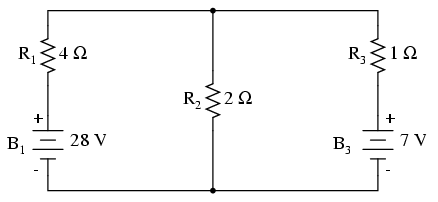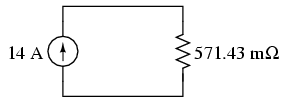Millman's Theorem
revisited
You may have wondered where we got that
strange equation for the determination of "Millman Voltage"
across parallel branches of a circuit where each branch
contains a series resistance and voltage source:

Parts of this equation seem familiar to
equations we've seen before. For instance, the denominator
of the large fraction looks conspicuously like the
denominator of our parallel resistance equation. And, of
course, the E/R terms in the numerator of the large fraction
should give figures for current, Ohm's Law being what it is
(I=E/R).
Now that we've covered Thevenin and Norton
source equivalencies, we have the tools necessary to
understand Millman's equation. What Millman's equation is
actually doing is treating each branch (with its series
voltage source and resistance) as a Thevenin equivalent
circuit and then converting each one into equivalent Norton
circuits.

Thus, in the circuit above, battery B1
and resistor R1 are seen as a Thevenin source to
be converted into a Norton source of 7 amps (28 volts / 4 Ω)
in parallel with a 4 Ω resistor. The rightmost branch will
be converted into a 7 amp current source (7 volts / 1 Ω) and
1 Ω resistor in parallel. The center branch, containing no
voltage source at all, will be converted into a Norton
source of 0 amps in parallel with a 2 Ω resistor:

Since current sources directly add their
respective currents in parallel, the total circuit current
will be 7 + 0 + 7, or 14 amps. This addition of Norton
source currents is what's being represented in the numerator
of the Millman equation:

All the Norton resistances are in parallel
with each other as well in the equivalent circuit, so they
diminish to create a total resistance. This diminishing of
source resistances is what's being represented in the
denominator of the Millman's equation:

In this case, the resistance total will be
equal to 571.43 milliohms (571.43 mΩ). We can re-draw our
equivalent circuit now as one with a single Norton current
source and Norton resistance:

Ohm's Law can tell us the voltage across
these two components now (E=IR):


Let's summarize what we know about the
circuit thus far. We know that the total current in this
circuit is given by the sum of all the branch voltages
divided by their respective currents. We also know that the
total resistance is found by taking the reciprocal of all
the branch resistance reciprocals. Furthermore, we should be
well aware of the fact that total voltage across all the
branches can be found by multiplying total current by total
resistance (E=IR). All we need to do is put together the two
equations we had earlier for total circuit current and total
resistance, multiplying them to find total voltage:

The Millman's equation is nothing more than
a Thevenin-to-Norton conversion matched together with the
parallel resistance formula to find total voltage across all
the branches of the circuit. So, hopefully some of the
mystery is gone now! |